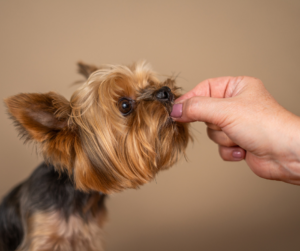Michael Baugh CDBC CPDT-KSA
The key to changing our dog’s unwanted behavior is pretty straightforward. We teach other behavior to replace the stuff we don’t want to see anymore (e.g. we teach standing on all four paws when we want to see less jumping up on people). In training sessions, this is pretty easy and we get quick results. But what about real life? What do we do to make sure our excellent results show up outside of training sessions?
 First, make training look like real life. Will you have a treat bag on all the time in real life? No. Okay, slip a couple treats in your pocket and ditch the bag for now. Will you always be sitting, standing, on the floor, or in a particular room in real life? No. Okay, train your dog in various positions and in various rooms. Create a picture of what real life with your dog looks like and train for that.
First, make training look like real life. Will you have a treat bag on all the time in real life? No. Okay, slip a couple treats in your pocket and ditch the bag for now. Will you always be sitting, standing, on the floor, or in a particular room in real life? No. Okay, train your dog in various positions and in various rooms. Create a picture of what real life with your dog looks like and train for that.
Then, make real life look like training. Teach your dog throughout your daily life with him.
Use your cues. Bring your training cues into everyday situations. This is the stuff you worked so hard to teach your dog in training sessions, behaviors on cue. Now we put that to use in the real world with our dogs. Most of my clients learn “mat”, “touch” (hand target), “come,” “sit,” “down” and other cues. Use those as needed. You taught them–why not benefit from them? Your dog will quickly learn these cues work for him in many parts of his life. Reinforce generously.
Notice your dog. This is hard for some of us. We are used to cueing behavior (above). But, we are not as used to noticing when our dog is doing something right on his own. Let’s work on that. We want our dogs to self-regulate. We want them making the right choices without having to be told. Look for him doing that–notice it. Reinforce good choices every time you see them. (Reinforcement is an investment in his making more good choices in the future).
Reinforce creatively. Food works. We all know that. So, yes, use food. And, let’s also think of other things our dogs will work for. Play comes to mind. Praise? Meh. But, praise with a big smile followed by play, or food, or a walk, or access to other dogs–that’s pure gold. Mix it up. Always reinforce behavior you want to see more of, whether you cued it or whether your dog offered it on his own. But, make the type of reinforcement you offer a surprise. Wonderful surprises reinforce good behavior.
I often talk about creating a culture of learning and teaching. That’s really what this is. We are making our life with our dogs a nonstop exchange of good for good. That helps our dog choose good behavior. And we are there to support those choices. Old-fashioned training was a top-down sort of thing. This is a back-and-forth exchange–communication between two species. Cool stuff. Magical moments that, all put together, make up real life.
Michael Baugh teaches dog training in Houston, TX. He specializes in helping families with dogs who have challenging behavior problems.
